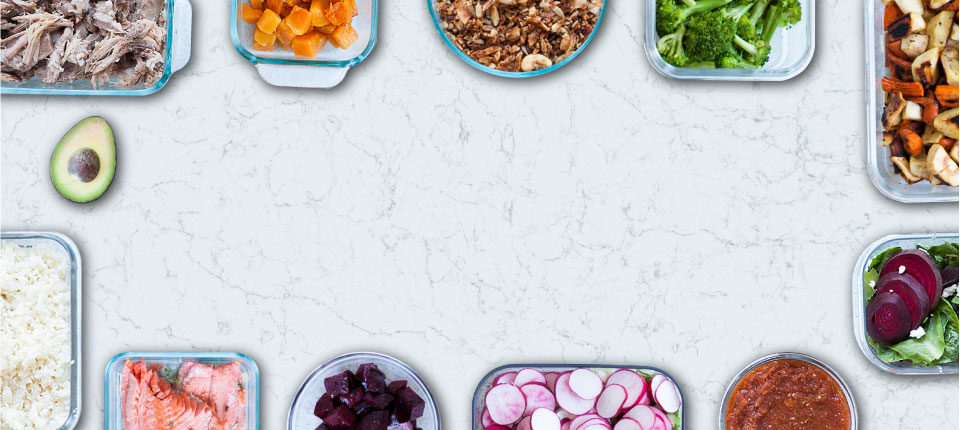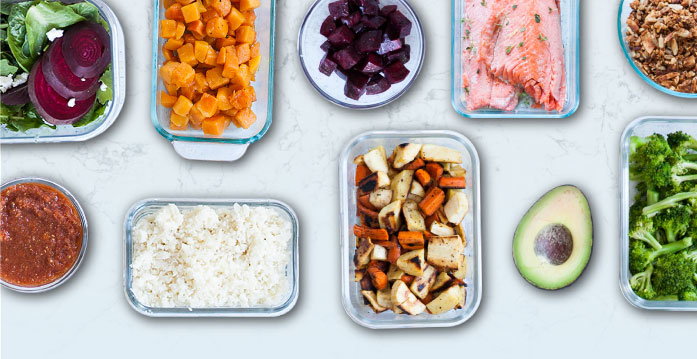It’s no secret that meal planning is one of the best ways to save money on food. As experts on the subject, us Real Planners love to geek out on ways to stretch your grocery budget.
The internet abounds with endless tips on how to cut grocery costs that provide varying degrees of wisdom and usefulness. But when it comes to helping health-conscious folks like you and me, often the consideration for food sourcing and true nutritional value are glossed over.
So how do make your grocery budget stretch without compromising your food values?
Choose your cheap fillers wisely
A common tip for feeding your family on a budget is to lean into bulk grains and beans and starchy vegetables like potatoes. And while that can be sound advice, it’s certainly just a start.
It is well-documented that many Americans are overfed and undernourished, meaning they consume calories in excess but maintain nutritional deficiencies that lead to other health issues beyond obesity in the long run.
A common solution to a limited food budget is to either buy cheap (junk) food or to load up on inexpensive carbs. And while carbs are not inherently evil, when it comes to filling your plate on a budget, we have an additional, more health-forward suggestion: VEGETABLES.
Some of our favorite ways to make a protein dish go further are to include inexpensive veggies like cabbage, cauliflower, zucchini, or squash. Aim to buy your vegetables in season for even extra savings. There’s no need to ditch your rice, lentils, pasta, and potatoes, but consider replacing some of them with affordable vegetables.
Here are some recipes to try:
Deconstructed egg rolls – with shredded cabbage and carrots
Roasted cauliflower and fennel with sausage – only three main ingredients
Spicy ground beef and butternut squash – super simple and family friendly
Spaghetti zoodle bolognese – A great way to get more veggies without giving up the joy of pasta!
Bottom line: Stretch your grocery budget with bulk grains, legumes, potatoes AND non-starchy vegetables.
Know when you can skip organic
When it comes to eating organic, one thing’s for sure, it costs more. So how do you know what to prioritize when you also want to stretch your grocery budget?
You’ve heard the saying, “You are what you eat.” In reality, it’s true, but not so simple. Eating fat doesn’t necessarily make you fat. Just like eating sugar doesn’t make you sweet. But eating processed junk does tend to wreck your body over time.
The fact is, buying organic, grass-fed and pasture-raised meat should be the priority above most organic produce since conventional meats are often much higher in pesticides, antibiotics, and unhealthy fats.
The EWG’s “Dirty Dozen” and “Clean 15” is still the gold standard – updated annually – to understand the best and worst fruits and vegetables in terms of pesticides.
“Dirty dozen” produce – try to always buy organic when you can:
Strawberries
Spinach
Kale/Collard Greens/Mustard Greens
Nectarines
Apples
Grapes
Cherries
Peaches
Pears
Peppers (bell and hot)
Celery
Tomatoes
“Clean 15” fruit and veggies that have the least pesticide exposure:
Avocado
Sweet Corn*
Pineapples
Onions
Papayas*
Frozen Sweet Peas
Eggplant
Asparagus
Broccoli
Cabbage
Kiwi
Cauliflower
Mushrooms
Honeydew Melon
Cantaloupe
*What about GMOs? Read this from the EWG website:
Under a law passed in 2016, beginning in 2022, some GMO food products in the U.S. must be labeled. However, based on the final rule released in 2018, these labels may be difficult to interpret, with confusing terms like “bioengineered.” Until the law takes effect, consumers who want to avoid GMOs may choose organic zucchini, yellow squash, sweet corn, papaya, apples and potatoes.
Bottom line: Stretch your grocery budget by skipping organic for produce that is not likely to be contaminated by pesticides (or genetically modified).
Invest in good fat
When it comes to fats, you need them in your diet. But the wrong fats, the cheapest ones like canola, vegetable, and corn oils, are quite unstable and will lead to inflammation in the body (read more here). That’s why it’s essential to invest in good fats like olive, avocado, and coconut oils. Butter or ghee (and even good quality bacon fat!) are great too.
To stretch your grocery budget and still get good quality fats, you don’t necessarily have to go with the most expensive. Sure cold-pressed, extra virgin, organic oils can be wonderful, but what you really want are pure and fresh healthy fats.
Buy the best quality you can afford, and unless you’re using them rapidly, don’t buy oils in massive vats. While you may spend less initially, if your oil oxidates or goes rancid before you use it, your savings will be in vain.
Bottom line: Good fats are important so choose them carefully and only buy them in quantities you will use quickly.
Do you have to be such a snob about grass-fed meat?
As we mentioned above, conventional beef is typically higher in pesticides, antibiotics, and unhealthy fats (and lower in essential fatty acids – Omega-3s and CLA) than organic, grass-fed, grass-finished beef. That said, even conventional meat is more nutritious pound for pound than plant-based substitutes.
When it comes to buying meat and poultry, the labels can be extremely overwhelming. While not all producers use this certification, The Global Animal Partnership (GAP) is a good place to learn about the ideal levels of standards for chicken farmers producers as well as producers of beef and other meat. You might be familiar with these ratings from Whole Foods or brands like Applegate Farms or Niman Ranch, but the best way to know if you are getting quality meat is to take the time to do your research, learn about where your meat comes from, and how it was raised.
But meat is so expensive, and the really good stuff is bound to be out of budget, right?
Not necessarily…
While the cost of food varies wildly, here’s a snapshot comparison of a pound of ground beef (85% lean/15% fat) as of March 2022:
- “All Natural” ground beef from Walmart $5.46/pound
- “Organic grass fed” ground beef from Walmart $6.28/pound
- “Grass fed and grass finish” (best quality) ground beef from Butcher Box $7.50/pound
Compare this with this meatless version (that have significantly less nutritional density):
- Black bean burgers for $6.46/pound
And just for fun, here’s the cost of a pound of… Snickers Bars ringing in at $7.51/pound!!!
Priced at $8.33/pound, Butcher Box sells step 3 boneless chicken breasts, a step below pasture-raised according to the GAP rating, which guarantees the birds have been raised with access to outdoors. Like beef, chicken raised with higher standards has provides better nutrition.
It’s a personal choice, but when you consider the health benefits, you may decide that better quality meat is worth a place in your food budget. Especially if you opt for cheaper cuts of meat including cuts like beef brisket, chuck, shanks, and cheeks; pork sirloin chop, collar, and belly; lamb shoulder chop, breast, and chump. And, of course, ground meat. Also, don’t forget the organs, which pack a hefty nutritional punch and flavor if you can get over any squeamishness.
Many of those cheaper cuts of meat are tough because of collagen, which has been shown to be beneficial for everything from skin to digestion. A long slow cook on tougher cuts will release the gelatin for tender and moist meat. Try our classic pot roast or slow-cooked pork.
Chicken thighs and whole birds are often bypassed for the same-sameness of breasts, but the former can be tastier and more versatile. Use them to make your own broth for soup, and use the meat to make an endless number of budget-friendly recipes like spaghetti squash with shredded chicken and pesto or chicken and corn chowder.
Bottom line: Pastured meats and poultry provide better nutrition and fewer health risks, hands down, but the best meat you can buy is better than none at all.
Don’t forget about eggs
For a dose of protein that’s inexpensive and quick to cook, look no further than the meal planning staple, eggs.
Fortunately, the myth that eggs are bad for you because they are high in cholesterol has been busted as scientists realized that the cholesterol we consume in food has actually little effect on our overall cholesterol levels.
Eggs are a nutrient powerhouse. Still, just like other animal protein sources, what is in them depends on how the chickens are fed. (Read how to choose eggs in this post.) But even a conventionally farmed egg provides bang for your buck.
And eggs aren’t just for breakfast. Toss a fried egg over a stirfry or scramble into fried rice – an easy source of protein and essential nutrition.
More ways to save without cheating your health
- Grow an herb garden – Those little packs of fresh herbs can break any budget, but a windowsill full of self-replenishing herbs will save you money and a sprinkle of joy (and healthy goodness) to your meals
- Become a soup-making junkie – There’s nothing quite like using the bones of a chicken or roast to create a nourishing soup that makes you feel like an accomplished (and penny savvy) home cook.
- Use your spice drawer – A jar of spices can last a while, so experiment with different flavors to keep your dishes deliciously diverse. Many spices have added health benefits too – think turmeric for its anti-inflammatory magic.
The need to stretch your grocery budget may feel dire, but it’s essential to factor in the cost to your health if you cut the wrong corners. Processed foods may seem cheaper, but investing in nutrient-dense food is cheaper in the long run when you consider what you’ll save on doctor visits, hospital stays, and medication for chronic illnesses.


